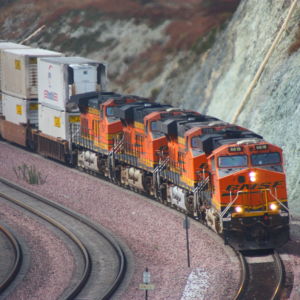A clear lesson of the coronavirus pandemic is that public policy affects people and consumers in real ways.
This is true at the local, state and federal level — whether it relates to stimulus money, distancing policies or even regulatory structures.
Observers of one industry in particular — our nation’s freight railroads — have rightly noted that it is a good thing private rail carriers are not regulated like public utilities.
Had they been treated like gas or electric companies in the lead up to today’s new reality, we wouldn’t have a reliable transportation network that keeps trains running through its own investments.
“[It] is clear that today’s freight railroads are still standing largely because lawmakers and regulators a generation ago recognized the power of markets and the dangers of excessive government intervention,” says transportation expert Marc Scribner.
Unfortunately, railroads have long fought potential regulation that would undermine their viability and that of their customers. Unlike trucks that use roads we all pay for, railroads pay their own way, like oil and gas pipelines or many broadband companies. In the past few years, railroads have spent more than $20 billion per year.
Yet for the past few years the industry has battled a threat to cap rates that railroads charge customers after they deem that the railroad has earned an “adequate” amount of money each year.
“Now, the [government] is considering the concept to limit rates — railroads deemed to be making enough money would not be allowed to raise rates even to replenish and replace equipment, build new track or otherwise expand,” says conservative columnist Brian McNicoll.
Railroads have also battled calls by some customers — or more aptly, lobbyists — to force railroads to allow competitors to use their own property. While systems of price controls or open access always struck market proponents as wrongheaded, the coronavirus pandemic has made it much clearer.
Instead of weathering the depressed economy, railroads would have pushed for massive amounts of government money like so many other sectors. But they haven’t.
Indeed, the reason for opposing utility-style regulations for railroads is simple: running a railroad is expensive, with most all costs borne by private industry, and limiting the ability to earn enough money would limit dollars put into the system.
As the Small Business and Entrepreneurship Council argues: “When government regulates the price of a good or service, that means government limits the potential returns on such endeavors, and creates political risks and uncertainties.”
That would leave rail customers and U.S. consumers holding the bag. Analysis by our friends at the American Consumer Institute shows that consumers enjoy some $10 billion in such benefits and savings because railroads are treated like most private businesses — particularly trucking, our other crucial mode for moving goods.
Leaders in Congress have thankfully rejected the call for further government interference in the rail sector. But nothing lasts forever and the structure emphasizing markets over government rate making will be 40 years old this October.
“Throughout this crisis there is no doubt that rail remains the firm and unyielding backbone of America’s transportation system,” my colleague Gerard Scimeca recently wrote. “And despite the fact that the economic downturn has seriously impacted their business, they are meeting the challenges of the pandemic without public funding.”
With new policymakers coming to Washington next year, it is a good time to remind folks that the current system works well.

